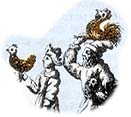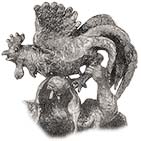|
Jewish Calendar - TISHREI - Yom Kippur
Perhaps the
best-known custom preceding Yom Kippur is the kapparot ceremony, in which
the sins of a person are symbolically transferred to a fowl. Verses from Psalms
and Job are recited.[1]
A fowl is then swung around the head three times, while the following prayer
is recited: "This fowl shall be in my stead, shall be my atonement, it
shall go to death, so that I can attain a good life and peace." It is believed
that the fowl will take on any misfortunes which might otherwise befall a person
in punishment for his sins.
In Babylonia
other animals were used, especially the ram, in remembrance of the ram offered
by Abraham in lieu of the sacrifice of his son[2]
or plants, peas and beans.[3]
In most communities it was customary to use a white rooster for a man and a
white hen for a woman. For a pregnant woman, two chickens were used (as in our
illustration) – one rooster and one hen, since it was known whether the
child would be a boy or a girl.
 |
Men and women swinging chickens
over their heads;
From Yom Kippur scenes,
in Kirchliche Verfassung der heutigen Juden,
by Johann C.G. Bodenschatz, Erlang, 1748.
Click
to view enlarged |
This kapparot rite is nowhere mentioned in the Talmud, and was first
recorded in the rabbinic writings of the geonim of the 9th century. Its primary
purpose was to serve as a vicarious sacrifice in place of the sacrifices offered
in the Temple which could no longer be practiced after the destruction of the
Temple. After the destruction of the Temple, it was forbidden to use animals
that had been used in the sacrificial cult for other similar purposes outside
the temple, and therefore fowls were employed (as they were not used in the
Temple sacrificial cult). If a cock or hen could not be obtained, the rabbis
permitted the use of other animals, such as fish or geese, although a white
rooster/hen was still considered most desirable, as it says in Isaiah: "Though
your sins be as scarlet, they shall be as white as show; though they be red
like crimson, they shall be [white] as wool. [4]
Many of the
older legal authorities demanded the kapparah ritual be abolished on
the ground that it appears very much like a sacrifice, which must not be offered
outside of the Temple; others vigorously opposed it because it was "a
heathen superstition" or "a stupid custom."[5]
The ritual, however, met with great favor among the people, especially through
the influence of the kabbalists, who elaborated it and invested it with mystical
interpretations.[6]
Those authorities who followed the mystical lore of the Kabbalah upheld and
encouraged the custom, while trying to eliminate from it any element that
might resemble the old sacrificial rite. Thus, chickens or geese, fish or
plants were permitted, but not pigeons and doves which were offered on the
altar in Temple times; while a fowl is to be preferred, one should not look
for it, since this is a heathen superstition.
|
Family
conducing the kapparah ritual.
From Yom Kippur scenes,
in Der Juden Glaube und Aberglaube,
by Friedrich A. Christiani, Leipzig, 1705.
Click
to view enlarged
|
|
Early
on this ceremony was associated with the distribution of charity, which
was always regarded as one of the most important behavioral factors
in obtaining divine mercy and forgiveness. After the ceremony, it was
customary to donate the fowl to the poor, except for the intestines
which are thrown to the birds. Some rabbis recommended that money, equivalent
to the value of the fowl, be given instead to the poor. In many communities–and
more and more frequently in the modern era–the entire ceremony
was performed with money, usually a multiple of eighteen, the numerical
value of the word hai (meaning life or living) and the money given to
charity. The kapparah, whether in the form of fowl or money,
was performed by every member of the household, and even in the name
of unborn babes.
|
The kapparah ritual, the best-known custom preceding Yom
Kippur, appears in etchings, illustrations, and sculptures, as
those in this article.
In his powerful sculpture The Prayer, Jacques Lipchitz has fashioned
a tattered old figure swinging a rooster over his head. This work was
done shortly after Lipchitz escaped the Nazi holocaust, and he used
the kapparot ritual as a grim, symbolic reminder of the slaughter
of his innocent fellow Jews in Europe.
|

The Prayer.
Sculpture
by Jacques Lipchitz, 1943.
Philadelphia Museum of Art
Click
to view enlarged
|
 |
[1] Psalms
107:10, 14, 17-21 and Job 33:23-24 [Back]
[2] Gen. 22:13 [Back]
[3] Rashi, BT Shabbat 81b [Back]
[4] Isaiah 1:18, BT Yoma 6:8 [Back]
[5] R. Solomon b. Abraham Adret, Nahmanides, Joseph Caro
[Back]
[6] Isaac Luria and Isaiah Horowitz [Back] |
 |
 Encyclopedia
Judaica, Vol. 10
Joseph Guttman, "Yom Kippur in Art"
Julius greenstone, "The Import of the Kapparot Ceremony"
Hayyim Schauss, "Yom Kippur in an East European Town"
in
The Yom Kippur Anthology (JPS, 1992) |
TISHREI Table of Contents
|



